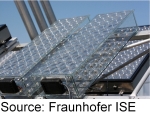
Many of the milestone advances in the development of high-efficiency III-V solar cells can be attributed to the pioneering work of the Fraunhofer Institute for Solar Energy (ISE) in Freiburg, Germany. A CLEANSORB model CS125SC dry scrubber, supplied by CS CLEAN SYSTEMS, has been in continuous use in the III-V Epitaxy laboratory since 1997 to abate the exhaust gases from an Aixtron 2600G3 Planetary MOVPE Reactor. The CS125SC system is configured to safely remove toxic arsine and phosphine gases, in addition to the pyrophoric liquid precursors used in the epitaxial growth of the multi junction crystal regimes under investigation. These include GaAs, AlGaAs, GaInP, AlGaInP, AlGaAsSb, GaNAsSb and GaInNAs.
With the fast-growing acceptance of concentrator photovoltaic solar cells for terrestrial markets, further research effort is now required to improve the economics of production. Up until now, this has been hampered by the prohibitive cost of the III-V and germanium wafers required as substrates. It is against this background that the Fraunhofer Institute has recently been awarded BMBF funding (03SF0329A) for a 300 mm Aixtron tool. The Close Coupled Showerhead reactor will be used to grow epitaxial germanium and III-V structures on commercially-viable silicon wafers. CS CLEAN SYSTEMS is pleased to announce that ISE recently placed an order for a second CLEANSORB CS125SC MOCVD dry scrubber for the new project.
Proprietary CLEANSORB materials are specially developed by CS CLEAN SYSTEMS for dry, room-temperature conversion of SiH4, GeH4, AsH3, PH3, among many other hydrides, to solid by-products. As the technology leader in dry chemisorption scrubbing for both the Silicon and Compound Semiconductor industries, CS CLEAN SYSTEMS is ideally positioned to serve the growing field of III-V-Si applications. In addition to this latest order, first CLEANSORB systems have also been installed for the waste gas treatment of Photonics-on-Silicon and other research activity aimed at exploiting the benefits of III-V materials on silicon circuits.

You must be logged in to post a comment.